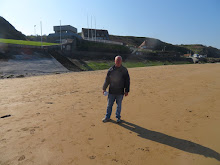Each year I change my profile picture to a picture of me from the preceding year that speaks to where I am or was in the recent pass. For instance, when I started this blog about 13 years ago, my first profile picture was me standing in a park on Staten Island, where I grew up, with the Verrazano-Narrows Bridge in the background. I was running the New York City Marathon the next day and it seemed a fitting portrait of my blog at that time.
Over the years I had profile pictures of me, if I remember correctly, standing before an Indian battlefield in Wyoming (the Fettermen Fight, formerly known as the Fetterman Massacre), eating a pizza, visiting a baseball park and attending a protest rally now that my Street Fighting Man days from the early seventies during the Nixon years have been necessarily revived during these Trump years.
Last year, 2019, my profile picture was a snapshot of me from November 2018 as I headed out to canvas for a democratic challenger, Jennifer Wexton, in the Tenth Virginia Congressional District running against the Republican incumbent in a seat that had been Republican for forty years. We flipped the seat, the first seat to be announced to have flipped during that entire historic blue-wave night. I was pretty proud to have contributed a meaningful effort that fall in the fight to preserve our rule-of-law nation.
For this year's profile picture I reached back to March 2019 when I visited Omaha Beach in Normandy, one of the five D-Day beaches that the Allies stormed 75 years earlier during Operation Overlord, the success of which presaged the utter destruction Nazi Germany eleven months later. Omaha Beach was the bloodiest and most bitterly contested of the five landing beaches and the initial shallow lodgment there almost failed, a catastrophe which would have unhinged the whole Allied line those first days and might have caused the American, British and Canadian troops to be driven back into the sea. Unlike at the other four beaches, the first wave of American troops at Omaha suffered mass slaughter wading ashore and for almost the whole day the Americans reached only the seawall, perhaps thirty yards past high tide, under which they sought shelter from the murderous fire raining down upon them from the bluffs beyond the narrow coastal strip. Orders were being prepared to withdraw them but in the afternoon intrepid soldiers singly or in pairs or clumps went up into the nearby hills, engaged the enemy and the beachead was preserved and enlarged as more troops came ashore. It was a close thing and a costly victory, with hundreds of Americans killed and thousands wounded on that beach alone. It is a reverential place for Americans to visit, haunted no doubt by the ghosts of shattered young men roaming ceaselessly among the ruined detritus of war still there decades later. It was a time when Americans were great and proud and wanted to make the world a better place, and weren't victims of seemingly hopeless circumstances wanting only to keep the world out by building a thousand-mile wall, separating families and caging children. My dad fought with the First Marine Division in the Pacific driving towards Tokyo and my girlfriend's dad fought with Patton's Third Army driving into Germany, and I was humbled to stand upon that hallowed beach in France yet suffused with pride at the can-do American spirit it represents.
Saturday, February 15, 2020
Subscribe to:
Post Comments (Atom)





No comments:
Post a Comment